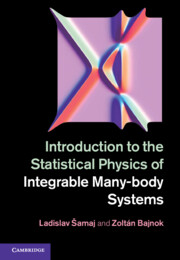Book contents
- Frontmatter
- Contents
- Preface
- PART I SPINLESS BOSE AND FERMI GASES
- PART II QUANTUM INVERSE-SCATTERING METHOD
- PART III QUANTUM SPIN CHAINS
- PART IV STRONGLY CORRELATED ELECTRONS
- PART V SINE–GORDON MODEL
- 22 Classical sine–Gordon theory
- 23 Conformal quantization
- 24 Lagrangian quantization
- 25 Bootstrap quantization
- 26 UV–IR relation
- 27 Exact finite-volume description from XXZ
- 28 Two-dimensional Coulomb gas
- Appendix A Spin and spin operators on a chain
- Appendix B Elliptic functions
- References
- Index
24 - Lagrangian quantization
from PART V - SINE–GORDON MODEL
Published online by Cambridge University Press: 05 June 2013
- Frontmatter
- Contents
- Preface
- PART I SPINLESS BOSE AND FERMI GASES
- PART II QUANTUM INVERSE-SCATTERING METHOD
- PART III QUANTUM SPIN CHAINS
- PART IV STRONGLY CORRELATED ELECTRONS
- PART V SINE–GORDON MODEL
- 22 Classical sine–Gordon theory
- 23 Conformal quantization
- 24 Lagrangian quantization
- 25 Bootstrap quantization
- 26 UV–IR relation
- 27 Exact finite-volume description from XXZ
- 28 Two-dimensional Coulomb gas
- Appendix A Spin and spin operators on a chain
- Appendix B Elliptic functions
- References
- Index
Summary
In this chapter, we quantize (preferentially) the sinh–Gordon model in the Lagrangian framework. We consider this theory as the perturbation of the free massive boson (Klein–Gordon model), which is quantized first. The potential is treated perturbatively; it is supposed to be weak in the sense that the particle spectrum of the free model is not changed. This assumption is valid for the sinh–Gordon theory, where the only particle already exists in the Klein–Gordon model. In the sine–Gordon case, however, additionally to the breather-type solution, which is the analog of the sinh–Gordon particle, there are non-perturbative particles like the soliton and the anti-soliton. Nevertheless, our approach is based on general field theoretical investigations and the conceptual consequences are valid for any theory of quantum particles, even for the quantum counterparts of the soliton and anti-soliton.
We start the chapter by introducing the quantum analog of the classical time shift, the scattering phase.We show how they are related in the semi-classical limit, which makes a bridge between the classical and quantum descriptions [214]. Then we turn to the quantization of the sinh–Gordon theory in the perturbative scheme: the free Klein–Gordon part is quantized first and then the interaction is taken into account in the interaction picture. We introduce the notion of asymptotic states and their scattering S-matrix. A reduction formula links the S-matrix to the correlation functions. This makes it possible to derive the crossing symmetry of the S-matrix and to investigate its analytical structure [215].
- Type
- Chapter
- Information
- Publisher: Cambridge University PressPrint publication year: 2013



